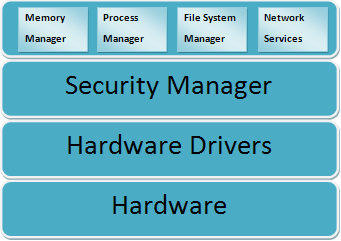| More on operating systems (OS) | |
Operating system (OS) has many jobs to do. Fundamentally it controls all of the hardware and software and is the first piece of software that is ran when a computing device boots up. Even though the OS is a very important piece of software it is still just software and is treated in exactly the same by the CPU. When the computer boots it will load up the OS into RAM. A personal computer could have more than one OS installed on it, like Linux and Windows XP. As such the OS must be loaded from storage and into RAM. This is normally from a hard drive into RAM, however simple command line based OS could be loaded off a CD or even a floppy disk. You can even use a pen drive to load a basic OS. It is not uncommon to load some graphical operating systems from CD, most notably Linux. The OS is split into different layers in order to do its jobs. The above diagram shows the OS split into basic layers. This is not the full story, but at this stage in the course it will be adequate for our purposes. The interested student should perform internet searches on the topic of OS layers. This will be looked at in much more detail in A2. The OS software is essentially a collection of smaller programs called modules. For example the memory manager is part of the OS but is essentially a self-contained module. The Operating system requires all of these modules working together in order to properly perform the required tasks.
|
|

 Custom Search
Custom Search
